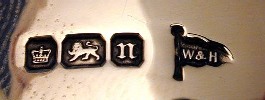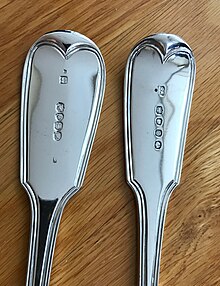
The standard circulating coinage of the United Kingdom, British Crown Dependencies and British Overseas Territories is denominated in pennies and pounds sterling, and ranges in value from one penny sterling to two pounds. Since decimalisation, on 15 February 1971, the pound has been divided into 100 pence. Before decimalisation, twelve pence made a shilling, and twenty shillings made a pound.

The English penny, originally a coin of 1.3 to 1.5 grams pure silver, was introduced c. 785 by King Offa of Mercia. These coins were similar in size and weight to the continental deniers of the period and to the Anglo-Saxon sceats which had preceded it.
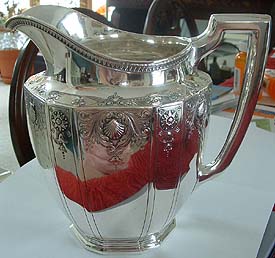
Sterling silver is an alloy composed by weight of 92.5% silver and 7.5% other metals, usually copper. The sterling silver standard has a minimum millesimal fineness of 925.

The Spanish dollar, also known as the piece of eight, is a silver coin of approximately 38 mm (1.5 in) diameter worth eight Spanish reales. It was minted in the Spanish Empire following a monetary reform in 1497 with content 25.563 g (0.8219 ozt) fine silver. It was widely used as the first international currency because of its uniformity in standard and milling characteristics. Some countries countermarked the Spanish dollar so it could be used as their local currency.
A hallmark is an official mark or series of marks struck on items made of metal, mostly to certify the content of noble metals—such as platinum, gold, silver and in some nations, palladium. In a more general sense, the term hallmark is used to refer to any standard of quality. Not to be confused with responsibility marks that are the marks of the maker.
Assay offices are institutions set up to assay precious metals. This is often done to protect consumers from buying fake items. Upon successful completion of an assay the assay offices typically stamp a hallmark on the item to certify its metallurgical content. Hallmarking first appeared in France, with the Goldsmiths' Statute of 1260 promulgated under Étienne Boileau, Provost of Paris, for King Louis IX.
The fineness of a precious metal object represents the weight of fine metal therein, in proportion to the total weight which includes alloying base metals and any impurities. Alloy metals are added to increase hardness and durability of coins and jewelry, alter colors, decrease the cost per weight, or avoid the cost of high-purity refinement. For example, copper is added to the precious metal silver to make a more durable alloy for use in coins, housewares and jewelry. Coin silver, which was used for making silver coins in the past, contains 90% silver and 10% copper, by mass. Sterling silver contains 92.5% silver and 7.5% of other metals, usually copper, by mass.
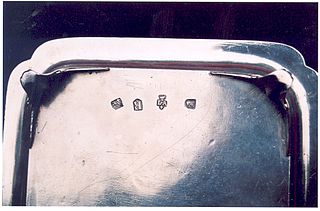
Britannia silver is an alloy of silver containing 11 ozt 10 dwt silver in the pound troy, equivalent to 23⁄24, or 95.833% by weight (mass) silver, the rest usually being copper.
This glossary of numismatics is a list of definitions of terms and concepts relevant to numismatics and coin collecting, as well as sub-fields and related disciplines, with concise explanations for the beginner or professional.
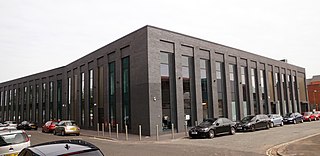
The Birmingham Assay Office, one of the four assay offices in the United Kingdom, is located in the Jewellery Quarter, Birmingham. The development of a silver industry in 18th century Birmingham was hampered by the legal requirement that items of solid silver be assayed, and the nearest Assay Offices were in Chester and London. Matthew Boulton and Birmingham's other great industrialists joined forces with silversmiths of Sheffield to petition Parliament for the establishment of Assay Offices in their respective cities. In spite of determined opposition by London silversmiths, an Act of Parliament was passed in March 1773, just one month after the original petition was presented to Parliament, to allow Birmingham and Sheffield the right to assay silver. The Birmingham Assay Office opened on 31 August 1773 and initially operated from three rooms in the King's Head Inn on New Street employing only four staff and was only operating on a Tuesday. The first customer on that day was Matthew Boulton.

The Hallmarking Act 1973 makes up the bulk of modern law regarding the assaying and hallmarking of metals in the United Kingdom. Hallmarking is a way to guarantee the purity of precious metals. Metals are tested and, if they meet a certain minimal purity requirement, are marked with a specified seal. In the United Kingdom, this is done by the assay offices in London, Birmingham, Sheffield, and Edinburgh. The act made business transactions involving unmarked metals illegal. Trading Standards departments are responsible for enforcing the act.
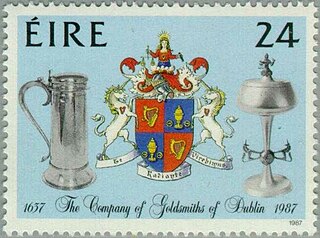
The Dublin Assay Office was established in 1637 to supervise the assaying of all gold and silver throughout the whole Kingdom of Ireland, when the Dublin Company of Goldsmiths was founded by royal charter, re-establishing the medieval Guild of All Saints.

Martelé is a limited hand-wrought production line of silver.
Silver standards refer to the standards of millesimal fineness for the silver alloy used in the manufacture or crafting of silver objects. This list is organized from highest to lowest millesimal fineness, or purity of the silver.
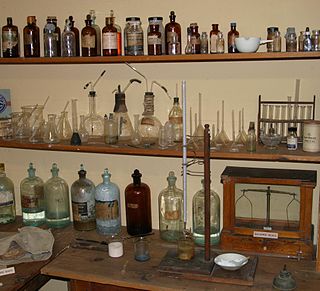
A metallurgical assay is a compositional analysis of an ore, metal, or alloy, usually performed in order to test for purity or quality.

The Eglinton Trophy or Eglinton Testimonial is a Gothic style Sterling silver centrepiece presented by friends and admirers to the 13th Earl of Eglinton to commemorate the medieval re-enactment known as the Eglinton Tournament held at Eglinton Castle, Kilwinning, North Ayrshire in 1839. At 4 foot 8 inch (140 cm) in height and 1600 ounces (45 kg) in weight it is one of the largest and most extravagant trophies of its kind.

The BIS Hallmark is a hallmarking system for gold as well as silver jewellery sold in India, certifying the purity of the metal. It certifies that the piece of jewellery conforms to a set of standards laid by the Bureau of Indian Standards, the national standards organization of India. India is the second biggest market for gold and its jewellery.
The Goldsmiths' Company Assay Office in London is the oldest assay office in the United Kingdom. The company has provided hallmarking services since The Goldsmiths Company was founded in the 14th century. The company received its royal charter in 1327 and ranks fifth in order of precedence of the 12 great livery companies of the City of London.

The Merchandise Marks Act 1887 was an Act of the Parliament of the United Kingdom.

Samuel Kirk was an American silversmith, active in Baltimore, Maryland, and best known for his introduction of repoussé to the United States. He engaged in various partnerships with his sons under the names of S. Kirk and Son and S. Kirk and Sons. In 1979 S. Kirk & Son was purchased by the Stieff Company, which renamed itself Kirk Stieff.
